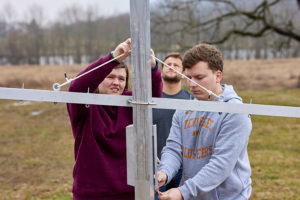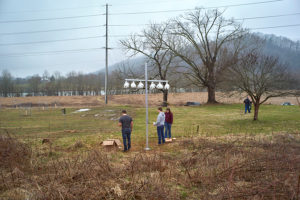
By David Goddard.
More than 400 distinct species of birds call Tennessee home, with even more taking up temporary residency during stopovers on migration paths to and from warmer climates.
 Wetlands, natural preserves, and other wildlife-friendly areas are crucial homes for the more permanent residents, while serving as key “rest areas” for those who spend their time elsewhere.
Wetlands, natural preserves, and other wildlife-friendly areas are crucial homes for the more permanent residents, while serving as key “rest areas” for those who spend their time elsewhere.
Seven Islands State Birding Park is one such area.
Located in southeast Knox County along the French Broad River, which separates it from Sevier County, the park and its more than 400 acres provide permanent and temporary habitat for a variety of animals, including a wide array of birds.
 A group of seniors from UT’s Department of Mechanical, Aerospace, and Biomedical Engineering (MABE) has recently begun wrapping up a senior design project with a component focused on improving outcomes for one avian visitor in particular, the purple martin.
A group of seniors from UT’s Department of Mechanical, Aerospace, and Biomedical Engineering (MABE) has recently begun wrapping up a senior design project with a component focused on improving outcomes for one avian visitor in particular, the purple martin.
“The team was challenged to come up with a design that made it easier for volunteers to take care of the gourds that the purple martins call home,” said Frida Roenning, a graduate student in the department and the team’s advisor on the project. “They came up with a solution involving pulleys and ropes that will allow the gourds to be raised and lowered for improved efficiency, while at the same time reducing the amount of equipment that staff need to haul to and from the site.”
Purple martins provide a good example of the range that birds found in the park can have, spending time as far north as Canada’s western provinces and as far south as Argentina.
 Because of the wide swath of space that the birds cover, this means any improvement in their breeding grounds—which include Seven Islands—could have an impact stretching thousands of miles.
Because of the wide swath of space that the birds cover, this means any improvement in their breeding grounds—which include Seven Islands—could have an impact stretching thousands of miles.
Another area where the MABE students are helping improve outcomes at Seven Islands occurs where most of its visitors first gain a glimpse of the park, the barn located adjacent to the parking area.
The barn and its environs serve to educate guests about what they might see in the park, some of its history, and as a display of native plants in the Wild Yards Garden.
UT’s team came up with a way to collect rainfall as it runs off the barn, providing water for the garden and other areas of the park while serving to highlight conservation efforts.
 “By having the rainwater collection and distribution system in such a highly visible part of the park, we can help people understand how it can serve as an important source of water for that area of the park, while also showing how they could take it and adapt systems like it to their own land,” said Bethany Jones, a senior on the project.
“By having the rainwater collection and distribution system in such a highly visible part of the park, we can help people understand how it can serve as an important source of water for that area of the park, while also showing how they could take it and adapt systems like it to their own land,” said Bethany Jones, a senior on the project.
Additionally, the park has a type of wetland called a vernal pool that could also use some of the collected water, benefitting plants and animals alike.